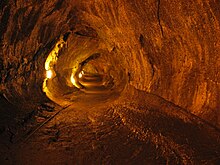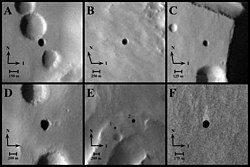Jaskinia lawowa



Jaskinia lawowa – naturalny tunel, utworzony przez lawę pod powierzchnią ziemi. Wypływa ona z wulkanu podczas jego erupcji. Tunele mogą odprowadzać lawę wulkaniczną ze źródła, bądź być pozostałością tego procesu w przeszłości.
Geneza
Jaskinie lawowe o pokroju tuneli tworzą się, gdy lawa o niskiej lepkości zastyga na powierzchni, podczas gdy we wnętrzu wciąż trwa przepływ. Ściany tunelu pogrubiają się wraz ze stygnięciem skał, ale trwający przepływ może powodować topnienie skał położonych niżej, obniżając dno tunelu i jednocześnie podwyższając ściany.
Położenie
Jaskinie lawowe są obecne w tych częściach świata, gdzie występują wypływy lawy typu pahoehoe, szczególnie na wyspach wulkanicznych. Do najdłuższych znanych tuneli lawowych na świecie należą:
- Kazumura Cave na Hawajach – 61 420 m długości
- Cueva del Viento na Teneryfie – 17 032 m
- Grutta das Torres na Azorach – 5150 m
- Ape Cave w stanie Waszyngton w USA – 3978 m
- Surtshellir na Islandii – 1970 m
Poza Ziemią

Jaskinie lawowe zostały odkryte także na Księżycu i Marsie, dzięki obserwacjom z orbity. Księżycowe tunele lawowe są uważane za jedno z lepszych miejsc do założenia bazy i rozpoczęcia kolonizacji Księżyca[1], jako że dają naturalną ochronę przed promieniowaniem i ekstremalnymi zmianami temperatury na powierzchni. Podobnie tunele lawowe na Marsie mogą w odległej przyszłości posłużyć kosmonautom jako schronienie przed promieniowaniem, mikrometeorytami i surowymi warunkami pogodowymi na powierzchni planety[2]. Ze względu na niższe ciążenie, tunele lawowe na Księżycu mogą mieć znacznie większe rozmiary niż na Ziemi, osiągając teoretycznie nawet 5 km szerokości[3]. Podobna możliwość, choć w mniejszej skali, zachodzi także na Marsie.
Zobacz też
- Caves of Mars Project
Przypisy
- ↑ Moon hole might be suitable for colony. CNN, 2010-01-01.
- ↑ R. D. "Gus" Frederick: Martian Lava Tubes Revisited. 1999. [dostęp 2010-08-20]. [zarchiwizowane z tego adresu (2013-01-19)]. (ang.).
- ↑ Krzysztof Kanawka: Duże jaskinie lawowe na Księżycu?. Kosmonauta.net, 2015-03-20. [dostęp 2015-03-21]. (pol.).
Linki zewnętrzne
- Przegląd Geologiczny- Jaskinie lawowe; BazTech
- Jaskinia lawowa Stefanshellir- Islandia. quarto.pl. [zarchiwizowane z tego adresu (2016-03-04)].
- Bob Gulden: Lista najdłuższych tuneli lawowych na świecie. (ang.).
Media użyte na tej stronie
Seven very dark holes on the north slope of a Martian volcano have been proposed as possible cave skylights, based on day-night temperature patterns suggesting they are openings to subsurface spaces. These six excerpts of images taken in visible-wavelength light by the Thermal Emission Imaging System camera on NASA's Mars Odyssey orbiter show the seven openings. Solar illumination comes from the left in each frame. The volcano is Arsia Mons, at 9 degrees south latitude, 239 degrees east longitude.
The features have been given informal names to aid comparative discussion. They range in diameter from about 100 meters (328 feet) to about 225 meters (738 feet). The candidate cave skylights are (A) "Dena," (B) "Chloe," (C) "Wendy," (D) "Annie," (E) "Abby" (left) and "Nikki," and (F) "Jeanne." Arrows signify north and the direction of illumination.Autor: Nunzio Santisi, Licencja: CC BY-SA 4.0
This is one of the longest tunnels scroll Etna. It penetrates into the cave through an opening in the ceiling along a steep slope formed by material collapse. In the south wall of this hillside overlooking a small secondary cavity consists of a short tunnel followed by a 2 m high chimney. Above the main gallery there is also a second long tunnel about 10 m wide and 2 m high at the beginning about 1.5; this gallery is not overlooking the main gallery, but is accessible from the lava field above. The floor is made from lava to the joint surface that sounds empty in step. The main part of the Cave of the Raspberries has two galleries, one downstream of the entrance, about 100 m long, affected by numerous collapses, the second upstream input, 300 m long in the best condition. The floor of the tunnel upstream consists of lava scoriae fragmentary or welded. Somewhere they are piled up large blocks of collapse. A collapse are also due the two openings on the ceiling that light up the gallery. The most downstream is a convenient second entrance. The most upstream is constituted by two holes in the ceiling; in correspondence of them there is a short tunnel located at a higher level, not easy to access. The section of the cave is mostly semi-circular, but in some stretch elliptical with the major axis horizontal. Stalactites to recast abound everywhere, as well as scratches and cords overlapping horizontal walls. There are many fractures on the vault. The main gallery presents the double side of the lower section; by the shortest of them departs a narrow passage that opens outside. Because of the different openings this cavity is very windy. Mungibeddu.it
Thurston Lava Tube, Hawai'i Volcanoes National Park, Big Island of Hawai'i, USA
Close-up of a skylight on coastal plain, Hawai`i Volcanoes National Park, with lava stalactites forming on the roof of the w: lava tube.



